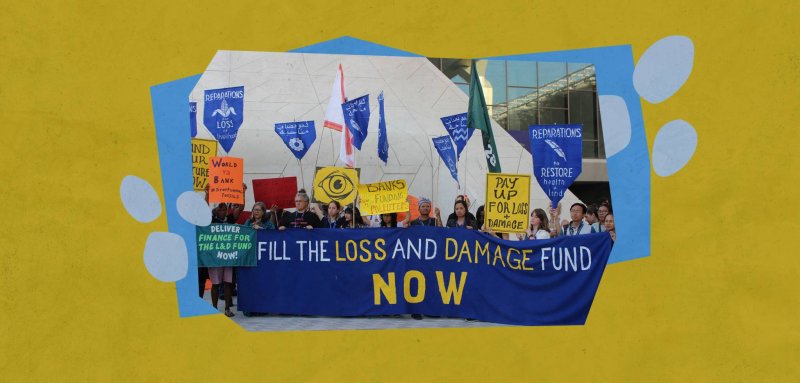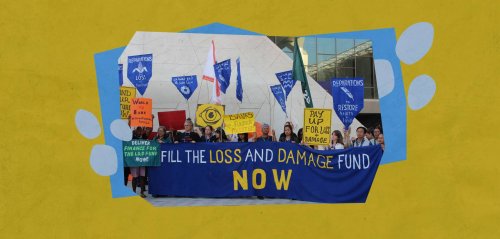On November 30, at the opening of the United Nations’ Climate Change Conference (COP28), a formal approval of the draft decision for the Loss and Damage Fund was reached. Delegates walked out of Dubai’s Expo2020 City with an air of triumph, and attendees went home with optimism.
At the end of the conference’s first week, the fund only had a combined total of slightly over $700 million pledged. The week ended with a demonstration calling on countries to “pay up for loss and damage.”
The Fund, proposed 31 years ago after Vanuatu, a small archipelago in the Pacific, proposed receiving compensation for loss and damage for climate-caused sea level rise, was set up to help poorer states damaged by climate disasters. With their smaller carbon footprints, they have historically done the least to cause the climate crisis but bear the brunt of its impacts.
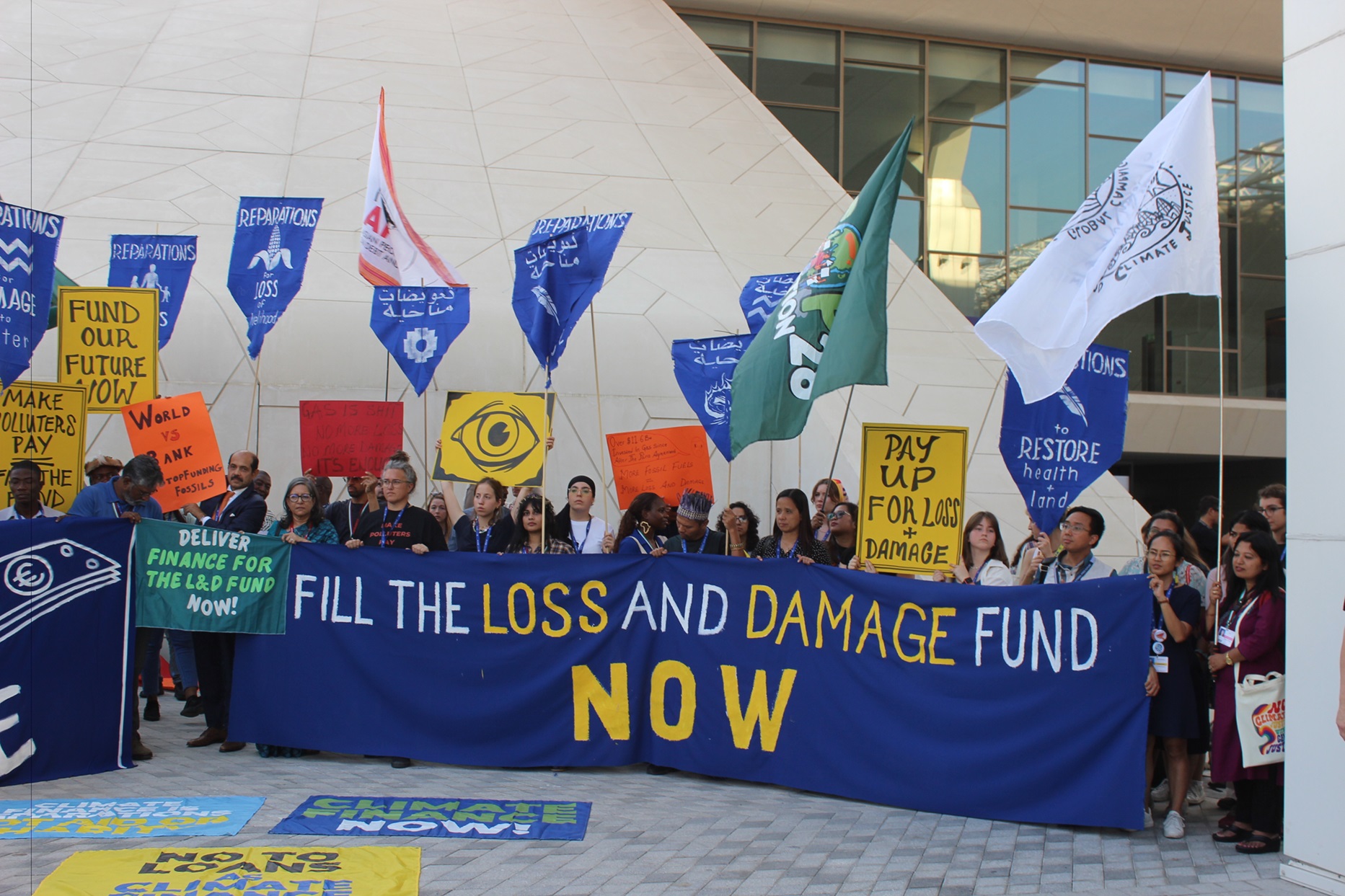 The first week of COP29 ended with a demonstration calling on countries to “pay up for loss and damage”
The first week of COP29 ended with a demonstration calling on countries to “pay up for loss and damage”
“On the one hand we welcome the fact that [the fund] was passed on the first day and that it has been secured. We fought long and hard for the process. But the recommendations were not what we thought,” Lidy Nacpil, coordinator at the Asian Peoples Movement on Debt and Development and COP 28 Coalition (APMDD), told Raseef22 at the protest.
The Loss and Damage Fund was set up to help poorer states damaged by climate disasters, but at the end of the first week of COP28, the fund hadn't collected the anticipated amounts, prompting a demonstration calling on countries to “pay up for loss and damage”
A bank is not fit for the purpose
Following decades of painstaking climate negotiations around climate finance, the deal to set up a Loss and Damage Fund was hailed as a breakthrough for developing country by negotiators at COP27 in Egypt in 2022. A transitional committee, representing a geographically diverse group of countries, was charged with designing the fund.
Until November of this year, meetings had been unsuccessful. In a fifth meeting in Abu Dhabi just three weeks ahead of this year’s conference, government negotiators finally reached a draft agreement.
Despite strong objections from developing countries, the World Bank would serve as interim trustee and host of the fund for a four-year period, and subject to being renewed.
“A bank is not fit for this purpose, it is for lending, and lending has contributed to the debt of countries,” Nacpil said, pointing out that the host of the Loss and damage Fund should be an independent entity.
Developing countries have argued that the World Bank, based in Washington DC and with US-appointed presidents, would give donor countries outsized influence over it, resulting in high fees for recipient countries. According to Nacpil, the US had been pushing for the World Bank to host the Fund during negotiations.
The US was among the higher-income countries that lobbied for Fund contributions to not be legally binding. Even though the US historically emits the most greenhouse gasses, is the world’s biggest economy and the largest producer of oil and gas this year, it committed a mere $17.5m to the Fund, subject to Congress’s approval. This drew instant criticism.
Developing countries have also bemoaned the World Bank for being slow, inefficient, unaccountable, imposing conditions that do not work for the Global South, and lacking the organizational culture to tackle climate change.
“We have problems with the World Bank’s policies and the kinds of projects it funds in the Global South,” said Nacpil, adding that the World Bank has a long history of funding fossil fuel projects.
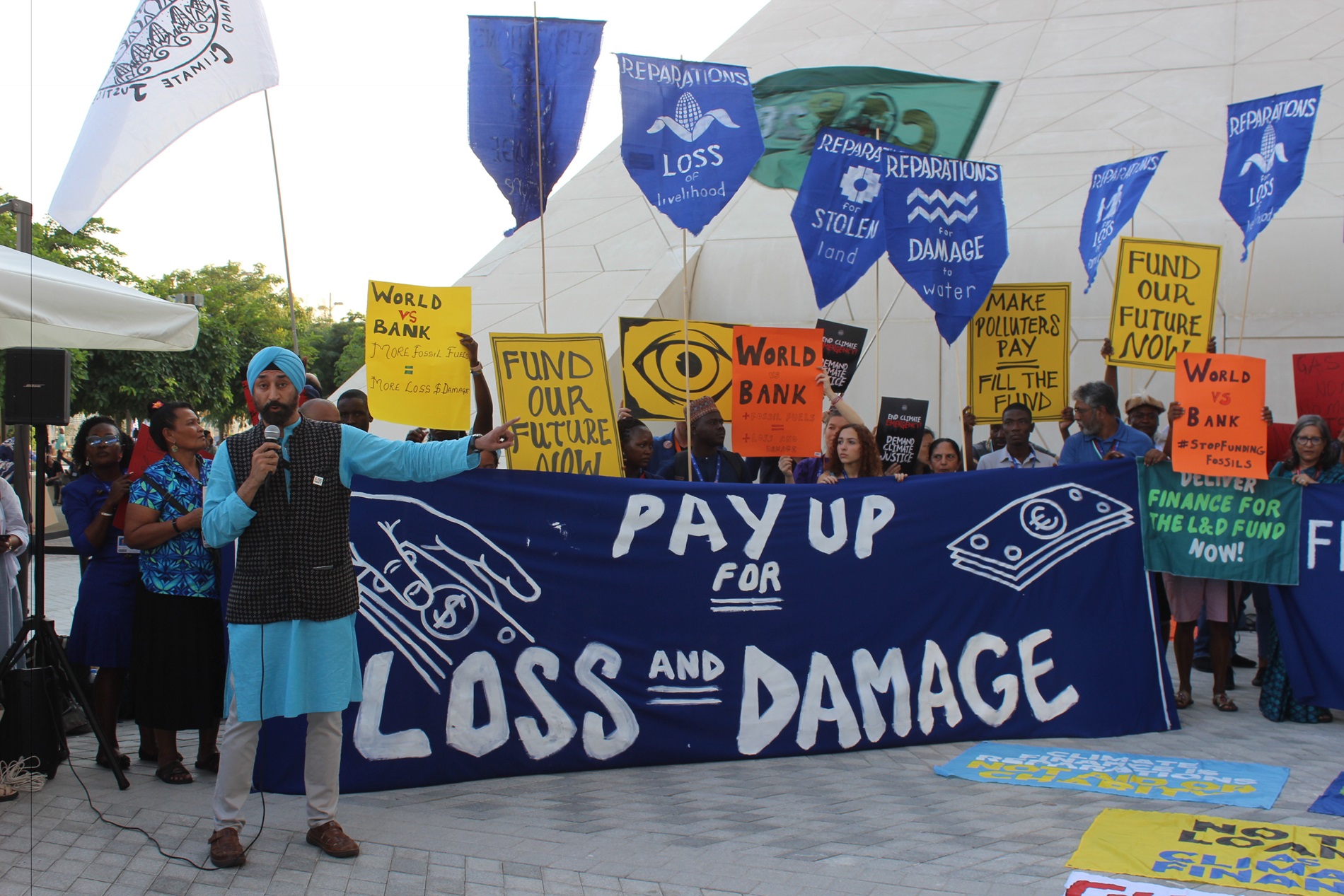 The first week of COP29 ended with a demonstration calling on countries to “pay up for loss and damage”
The first week of COP29 ended with a demonstration calling on countries to “pay up for loss and damage”
Grounds for financing the aftermaths of climate catastrophes
Whether funding for climate-devastated countries will be in the form of debts or loans is still up for debate, with expectations that it will ultimately be a combination of both.
“The climate finance question is really a climate debt question because the Global North has exceeded its carbon budget by far, and therefore has a climate debt,” Fadhel Kaboub, associate professor of economics at Denison University and president of The Global Institute for Sustainable Prosperity, told Raseef22. “When you have debt you have to pay it, not give loans and expect interest, and not set conditionalities on how the money is used,” he added.
Kaboub criticized developed countries for “not [being] serious about climate finance”, and stating that financing a just transition should not be dependent on market based solutions. “Because markets do what markets do, which is extract profits.”
“The funding [so far] is outrageous. It should be in the trillions, not millions”.. To put the numbers into perspective, some of the money pledged to the Loss and Damage Fund would cover only about an hour’s worth of climate crises in developing countries
One of the points which developing countries and civil society have successfully fought for is the language around access to the Fund. Direct access for developing countries has been secured in the text in the operationalized agreement, Nacpil noted.
Yet, which countries will benefit from the funding is still a point of contention. Higher-income countries want the funds to be allocated “based on vulnerability”, despite the text not clearly defining this. They would also prefer that only the lowest-income countries be eligible for funding, ruling out middle-income countries such as Libya and Pakistan, who would benefit from international aid in dealing with the effects of the recent and devastating climate-related flooding.
Conflict-affected nations also face significant challenges accessing climate finance assistance due to concerns about instability, ineffective governance, and a reduced capacity to execute projects that can generate returns for investors. This would rule out countries including Yemen, Syria, and Palestine, from obtaining necessary aid.
According to Nacpil, “There is a lot of push for constraints, they want fewer countries to be eligible, and a narrower basis of what loss and damage will cover.”
The new Fund board is mandated to hold its first meeting by 31 January 2024. The board will determine which countries can qualify for aid, how they can apply, and how and when funds will actually be dispersed.
Conflict-affected nations face significant challenges accessing climate finance assistance due to concerns about instability, ineffective governance, and a low capacity to execute projects, excluding countries like Yemen, Syria and Palestine from obtaining aid
Currently, the specifics of these arrangements and mechanisms are under deliberation at Global Stocktake (GST). On Tuesday, the initial draft text was released, and contained significant wording outlining the extent of loss and damage, as well as linking future requirements of climate mitigation efforts and funding for adaptation.
‘Fill up the loss and damage’
The agreement was not specific about who must contribute, and it did not specify a scale for the fund.
Developing countries will need an estimated $2.4 trillion in annual climate finance by 2030 to fund a just transition “if we take the science and the economics seriously”, according to Kaboub.
 The first week of COP29 ended with a demonstration calling on countries to “pay up for loss and damage”
The first week of COP29 ended with a demonstration calling on countries to “pay up for loss and damage”
A recent report by the United Nations estimated that up to $387 billion will be needed annually to implement domestic priorities of adaptation to climate-driven changes. Other sources estimate the number to be $600 billion annually.
Protestors on Wednesday demanded, “fill up the loss and damage,” which echoed through the COP28 venue. While protests are illegal in the United Arab Emirates (UAE), all rallies and demonstrations take place in COP28’s Blue Zone, run by the UN.
“The funding [so far] is outrageous. It should be in the trillions, not millions,” Nacpil said.
Wealthier countries are demanding that rapidly growing countries with high carbon emissions, like China, Qatar, and Saudi Arabia, contribute to the fund.
“The climate finance question is really a climate debt question because the Global North has exceeded its carbon budget by far, and therefore has a climate debt. When you have debt you have to pay it, not give loans, expect interest, or set conditionalities”
The UAE set an example by contributing $100 million to the Fund. Germany matched this contribution, the European Union pledged $246 US million, and Italy and France each promised $108m. The United Kingdom pledged $60 US million, while Japan committed $10 US million.
Canada, a top-five oil producer globally, pledged $16 million to the fund, which put into perspective, would cover only about an hour’s worth of climate crises in developing countries.
“We need to turn up the heat... Developing countries have to stand firmly, so that rich countries are compelled to deliver on their obligations,” Nacpil asserted.
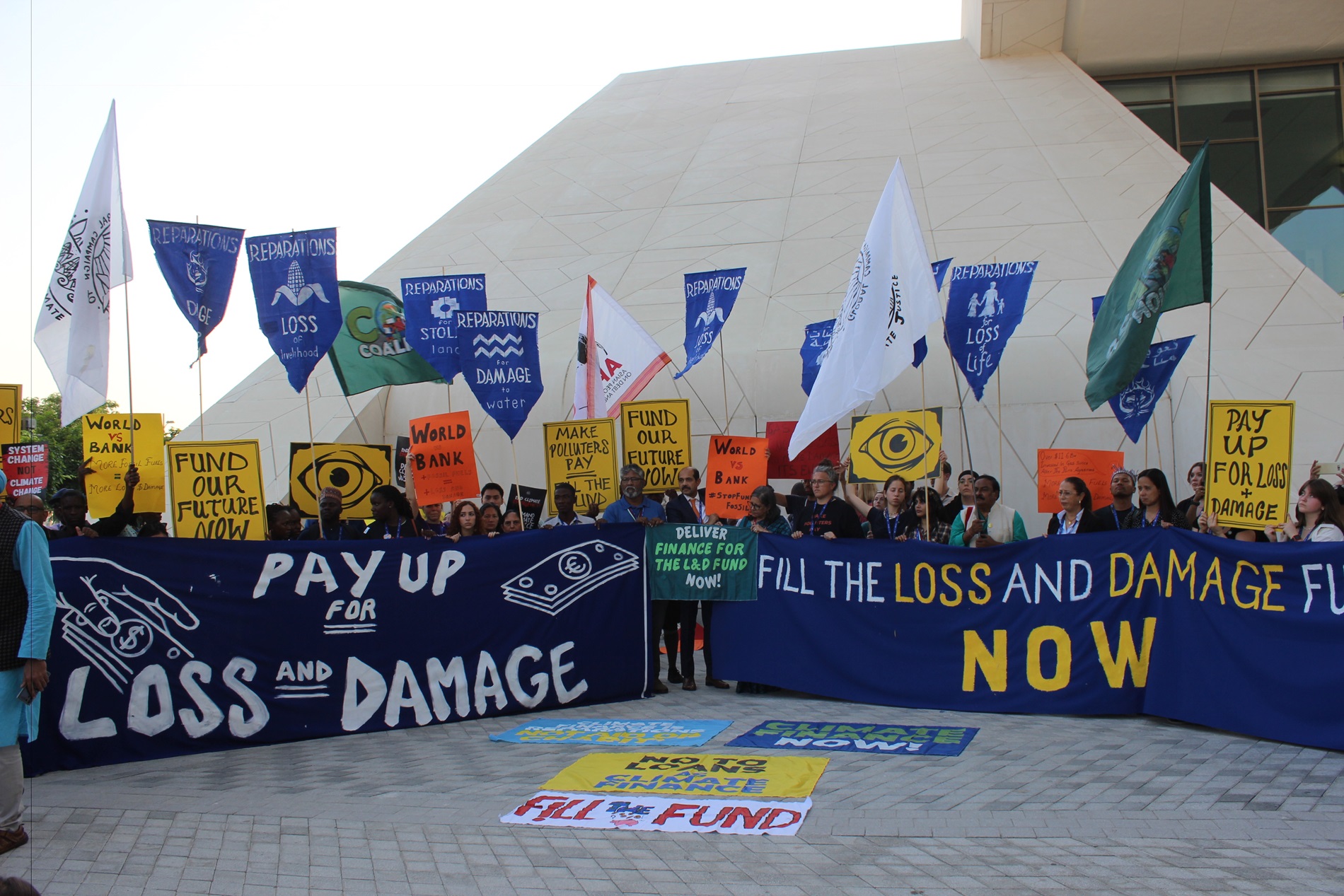 The first week of COP29 ended with a demonstration calling on countries to “pay up for loss and damage”
The first week of COP29 ended with a demonstration calling on countries to “pay up for loss and damage”
Raseef22 is a not for profit entity. Our focus is on quality journalism. Every contribution to the NasRaseef membership goes directly towards journalism production. We stand independent, not accepting corporate sponsorships, sponsored content or political funding.
Support our mission to keep Raseef22 available to all readers by clicking here!
Interested in writing with us? Check our pitch process here!
